
South Australian Medical Heritage Society Inc
Website for the Virtual Museum
Home
Coming meetings
Past meetings
About the Society
Main Galleries
Medicine
Surgery
Anaesthesia
X-rays
Hospitals,other organisations
Individuals of note
Small Galleries
Ethnic medicine
- Aboriginal
- Chinese
- Mediterran
F.H. Fauldings & Company Limited
[author - see below]One pharmaceutical enterprise which put greater emphasis on the manufacturing side of its business and whose successors strengthened this emphasis was Faulding's. A pharmacist, Francis H. Faulding, started his shop in Adelaide in 1841 and formed a partnership with an English physician, L. Scammel, in 1861.
From its beginnings the firm showed a flare for innovation. After Simpson's discovery of the anaesthetic properties of chloroform in 1847, Francis Faulding was the first to import chloroform; in 1858 he distributed cocaine preparations; in 1864 he produced the first olive oil from South Australian olives and, after J. Lister's reports in Lancet on the reduction of mortality after surgery with the use of phenol, Faulding began production of antiseptics ('Solyptol') in 1867. Faulding was also the first to utilize the medicinal and antiseptic properties of eucalyptus oil which was obtained from distilleries on Kangaroo Island
The Second World War in Europe disrupted the supply of cod liver oil, an important source of Vitamin A. Faulding chemists found an alternative source in white schnapper shark, which sustained supplies in Australia as well as generated exports to the UK .
When supplies of I.G. Farben's newly discovered sulpha drugs ran out, Faulding became involved in the national program organised by the Medical Equipment Control Committee (MECC) and, jointly with universities, synthesised sulphanilamide. Following the transfer of American knowhow. Faulding's was also the first private enterprise to produce yet another life saving drug of military importance, penicillin.
After the war basic synthesis of antibiotics became difficult to sustain by private enterprise because of the gigantic scale advantages of competing US producers, and competition in the synthesis of new drugs demanded huge investment in R & D; Fauldings maintained their business by a combination of marketing, wholesaling and producing consumer and medical products.
In the 1970s, however, Fauldings set a remarkable precedent in research strategy and achievement in the Australian pharmaceutical business. They decided to concentrate their research on drugs which had proven efficacy, but which also suffered from certain shortcomings restricting their clinical usefulness, and to seek advances overcoming these shortcomings. This was an imaginative new strategy, a way of grafting Australian knowhow on to major products, in keeping with local resources and yet offering opportunities for sophisticated skill. At the same time it promised to open international markets, since the major producers of the basic drugs could hardly ignore significant advances.
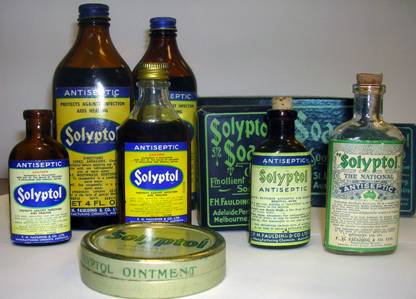
“Solyptol” antiseptic products in the museum of Fauldings Pharmaceuticals Salisbury
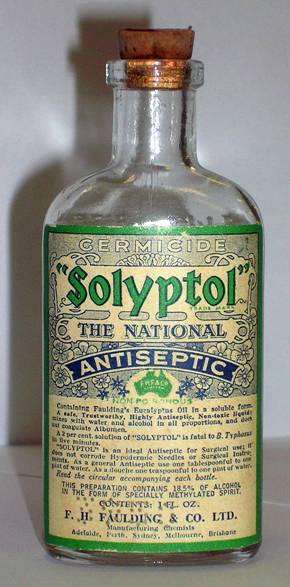
“Solyptol” bottle (liabel reads “containing Faulding’s Eucalyptus Oil in a soluble form”.
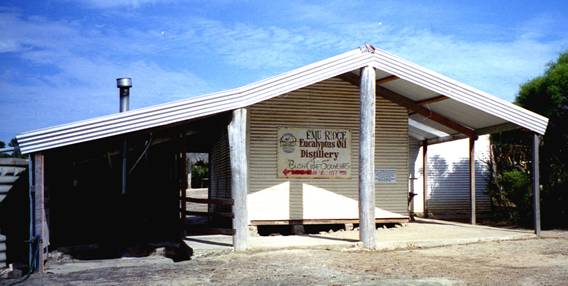
The only remaining eucalyptus oil distillery on Kangaroo Island
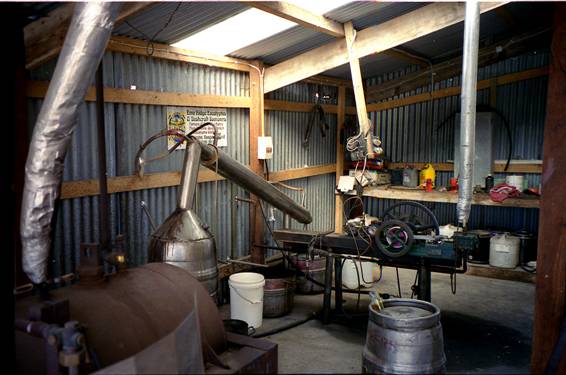
Interior of the only remaining eucalyptus oil distillery on Kangaroo Island
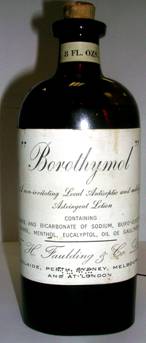
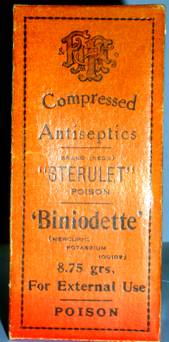
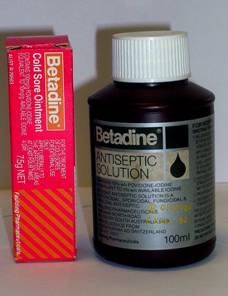
Borothymol biniodate, betadine ointment, & solution
Museum examples of Faulding’s antiseptic products
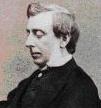
Francis Hardy Faulding
1816-1868
The year 2005 was the 160th. anniversary of the founding of the firm by Francis Hardy Faulding, who was born in the Yorkshire town of Swinefleet His father was a surgeon, and Francis followed in his footsteps
He sailed for Adelaide on the immigrant ship “Naob” in 1841 as assistant surgeon and arrived in Adelaide a year later. Within three years Francis had acquired property and became known as a ‘ Rundle Street gentleman’, which placed him well to open his retail pharmacy business on19 May 1845 at 5 Rundle Street.

In 1861 Francis formed a partnership with an English immigrant physician named Luther Robert Scammell and thus the company traded under the name of F. H. Faulding & Co.
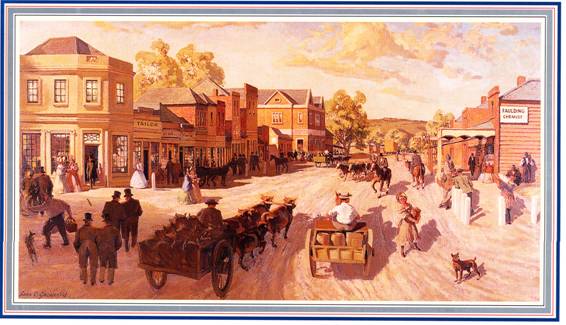
Rundle Street Adelaide 1845 Oil Painting By John Goodchild Comissioned By A.F.Scammell In 1945 To Mark 100 Years of Fauldings (based on S.T.Gill’s Painting)
Here he dispensed physician’s and surgeon’s prescriptions , medicine chests to people like John M’Douall Stuart’, also toilet requisites, as well as sheep, cattle, and horse requisites. The drugs and remedies were simple and based on naturally occurring substances and family recipes.
Francis’s brother, Joseph remained in England and helped Faulding become an importer and distributor of drugs & patent preparations. By 1850 Faulding was selling several proprietary lines such as “Faulding’s anti-bilious, aperient pills”, “Pectoral pills” & ointments for ringworm.
After consolidating Scammells' dispensary. and Faulding's various distribution and manufacturing activities, Faulding began to diversify the 'Phoenix' Trade mark. From its beginnings, the firm showed a flair for innovation.
After Simpson's discover of the anaesthetic properties of chloroform in 1847, Francis Faulding was the first to import chloroform. In 1858, he distributed cocaine preparations & in 1864 he produced the first olive oil from South Australian olives.
After Joseph [later Lord] Lister's reports in the Lancet on the reduction of mortality after surgery with the use of phenol, Faulding began production of antiseptics ("Solyptol") in 1867.
Faulding was also the first to utilize the medicinal and antiseptic properties of eucalyptus oil which was obtained from distilleries on Kangaroo Island and produced under the direction of Ernest Arthur Scammell. At the 1887 South Australian Jubilee Exhibition, Faulding displayed its eucalyptus oil to the world.
In 1896 Samuel Barbour, Faulding's senior manufacturing chemist, travelled to England and saw the earliest X-Ray pictures. Upon his return he worked with Waler Rowe, another Faulding chemist, & William [later Sir William] Bragg from the University of Adelaide & produced the first Australian X-Ray pictures.
The Second World War in Europe disrupted the supply of cod liver oil, an important source of Vitamin A. Faulding chemists found an alternative source in White Schnapper (or School) Shark, which sustained supplies in Australia as well as generating an export to the UK.
When supplies of I.G. Farben's newly discovered sulpha drugs ran out. Faulding become involved in the national program organised by the Medical Equipment Control Committee (MECC) and, jointly with universities, synthesised sulphanilamide.
Faulding's was also the first private enterprise to produce yet another life saving drug of military importance, Penicillin. After the war, basic synthesis of antibiotics became difficult to sustain by private enterprise because of the gigantic scale advantages of competing US producers; Faulding's maintained their business by a combination of marketing, wholesaling and producing consumer and medical products.
In 1969 a landmark corporate plan was developed which saw Faulding's in the 70's set a remarkable precedent in research strategy and achievement for an Australian pharmaceutical business.
The company reformulated high technology drugs and decided to market its products internationally. A number of non-profitable lines were deleted from production. So, began the release of many drugs we know today. Betadine was launched in 1971, and in 1977 the broad spectrum antibiotic Eryc. In 1984 Faulding acquired David Bull Laboratories and expertise to manufacture injectable anti-cancer drugs.
In 2001 Mayne Group acquired FH Faulding & Co Limited.
"Faulding clearly provides a bridge between logistics and health and that was fundamental to the overall rational of the organisation we have brought together" 1.
Today, Faulding's is a truly international pharmaceutical manufacturing company focused on Research & Development, marketing and distribution of injectable generics and speciality pharmaceuticals.
In November 2005 shareholders will vote to demerge the company into two separate companies, Mayne Pharma Health and Symbion Health.
Dianne Gall,
Mayne Pharma Librarian, November 2005
1 Mayne Group 'Connect' Feb 2002
This document has been compiled with reference to "The Faulding Formula - A History of FH Faulding & Co Limited" by Donavan, Peter & Tweddell, Ed. 1995
-o0o-